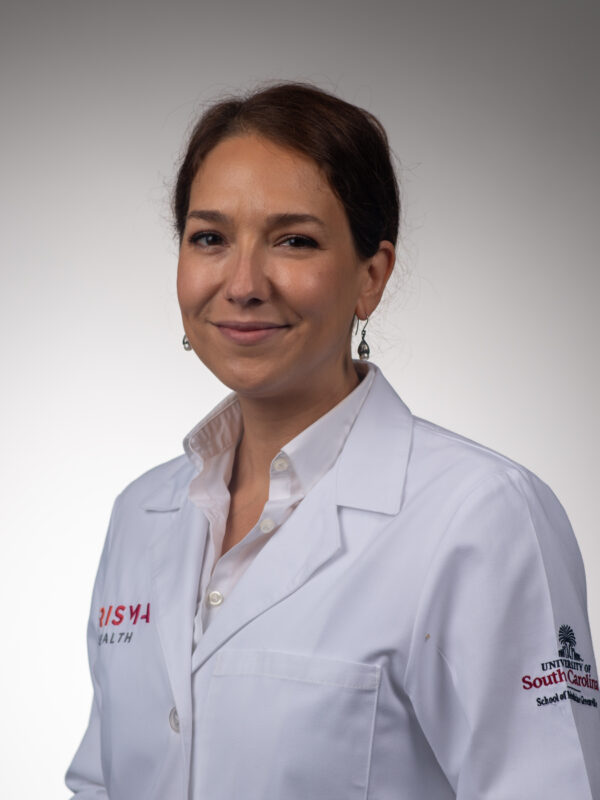What to know about head and neck cancer screening
Head and neck cancer can be caused by using tobacco or by catching the extremely common human papillomavirus. Head and neck surgeon Mariangela Rivera, MD, explains how screenings can help catch the disease early and how treatment has vastly improved over the past 20 years.
Transcript
Joey Wahler (Host): It’s a disease that can be caused by using tobacco or possibly by having a sexually transmitted infection. So we’re discussing head and neck cancer and its treatment. Our guest, Dr. Mariangela Rivera. She’s a head and neck surgeon with Prisma Health. This is Flourish, a podcast from Prisma Health. Thanks for listening. I’m Joey Wahler. Hi, Dr. Rivera. Thanks for joining us.
Mariangela Rivera, MD: Hi. Thank you for, for having me.
Host: Great to have you. So first, what is considered head and neck cancer and what are its main causes typically?
Mariangela Rivera, MD: Head and neck cancer can be anything from a skin cancer arising on the skin above your collarbone, but most often it’s what’s called squamous cell carcinoma, which comes from the lining of the mouth and throat. That’s about 90% of all head and neck cancers, and then there’s several others such as tumors of the salivary glands, tumors in the nose, and obviously thyroid cancers.
Host: And so take us through what some of those main causes are. I alluded to that a little bit at the top.
Mariangela Rivera, MD: So the most common cause of head and neck cancers now is human papilloma virus or HPV. This causes cancers in the tonsils, and the base of the tongue. We’re seeing an increased incidence of these, nowadays, but previously before HPV started taking over, the other main cause of head and neck cancers with smoking and smoking as well as drinking alcohol can increase your risk of cancers in the mouth, the throat and the voicebox.
Host: Okay, so just to follow up a little bit on each of those. HPV is a sexually transmitted infection, and why does that seem to be on the rise do you think, as a cause of this type of cancer?
Mariangela Rivera, MD: HPV is a ubiquitous virus that’s found all over. Any human being who’s had sexual contact with another human being has probably been exposed to HPV in some way, shape or another. Changing sexual habits and increased sexual activity has increased incidence of HPV in the throat. Also the way that we detect cancers has changed.
We’re a lot more sensitive about these things now, and I think that may have increased the incidence. Lastly, the other kinds of head and neck cancers caused by smoking have decreased. So just the relative numbers of HPV associated tumors, have increased compared to the ones that we would see before that were traditionally caused by smoking and drinking.
Host: Interesting. And so why do you think the latter is the case? Why are those causes on the decline?
Mariangela Rivera, MD: Fewer people are smoking. So, the newer generations of kids just don’t think it’s cool anymore. Thank goodness. The decreased incidence of smoking in the United States has decreased the overall incidence of smoking related cancers, which is a good thing.
Host: Absolutely. I can remember as a little kid growing up, I’d buy the bubble gum cigarettes and I’d think it was cool just to look like I was smoking, even though I wasn’t making it look like smoke was coming out when it was actually powder on the gum right?
Mariangela Rivera, MD: Yep. Even things like movies, so the way that movie production is done, you read some articles about actors who talk about, well, my character really needed to smoke to really offer a character that was more complete and that’s gone away. Most recently, I remember reading an article saying that Cruella Deville in the 101 Dalmatians had a cigarette that she had in the movie, in the cartoon and in the live action version, they were not allowed to do that.
Host: Sure. I doubt we’ll see very many cartoons produced from here on where characters are smoking, right?
Mariangela Rivera, MD: Exactly. So approaching kids from that early age makes a big difference.
Host: Absolutely. So are there any warning signs people can look for for head or neck cancer?
Mariangela Rivera, MD: The most common sign of head and neck cancer in most patients is actually a painless lump in the neck. Most patients who present with a tumor are just going to have a lump that doesn’t get better. They might take antibiotics and it still stays there. Other things to worry about, would be changes in the voice in particular and difficulty swallowing associated with weight loss that doesn’t improve. All of those can be signs that there’s a head and neck cancer lurking.
Host: Gotcha. And if there is one lurking, this normally affects older people, generally speaking. Am I right? What age group do we mean?
Mariangela Rivera, MD: Absolutely. So the most commonly affected age group is between the ages of 60 and 80. There’s about 23 cases per hundred thousand people per year in that age population. Younger patients aren’t totally out of the risk zone. Patients between the ages of 40 and 60, there’s about 13 cases, per hundred thousand people. So, you know, when I first started my career, I said that HPV would probably keep me in business for the length of my career, and hopefully with the HPV vaccine, we’ll see those numbers continue to go down.
Host: Understood. So what about screening? We hear so much all over the medical world about screening, early detection for prevention. What screening is available here and does head and neck cancer show up in blood work?
Mariangela Rivera, MD: Gosh, I wish it showed up in blood work. So there are some rare thyroid cancers that you can find just with blood work, but for the most part, you need to have someone take a look. We do an annual head and neck cancer screening with the Prisma Baptist. And we get a couple of local community providers to help us out with that screening event. But generally, your primary care doctor should be taking a feel of your neck and they should be taking a look in your mouth, to see if there’s any signs. It’s very quick and is actually pretty sensitive.
Host: What about when your dentist pokes around with his finger during your annual checkup, kind of around your tongue and such? Is that part of that or no?
Mariangela Rivera, MD: Absolutely, and I frequently talk to dentist groups here in town to promote exactly that. Everyone who’s looking in the mouth for any reason should be doing a tactile exam, feeling the back of the throat, as well as feeling the neck.
Host: So if you do get one of these cancers, what kind of a treatment option list are we talking about?
Mariangela Rivera, MD: Treatment for almost all head and neck cancers involves a combination of surgery, radiation, and chemotherapy. Depending on what kind of tumor you have, it might just be one of those modalities where typically it would be just be radiation or just surgery, but almost always it’s a combination of two. Usually we recommend a combination of surgery followed by radiation or radiation and chemotherapy combined together.
Host: Seems like overall compared to some other cancers, that head and neck don’t necessarily get the attention that those do. Am I right?
Mariangela Rivera, MD: That’s absolutely true, and I wish we had a better PR campaign. Head and neck cancers are more rare than say, breast cancer or colorectal cancer. But they still affect people, fairly regularly and they affect people in ways that are really intimate to our day-to-day lives. Head and neck cancers can really make swallowing and speech very difficult, and those things are really important as social creatures. So I wish we had better PR. Thankfully there have been some actors who’ve come out and talked vocally about their disease. I just wish there were more people who were open about their disease and, we had more events that would bring this to light.
Host: Sure. A couple of other things, so just going back to what you mentioned a moment ago, how your general care physician should basically do a quick exam as part of his overall or her overall exam to check for this. If they’re not doing that, should you ask them to?
Mariangela Rivera, MD: Absolutely. Your GP should be including at least a good physical exam once per year. And that should include palpation of the neck or feeling the neck for lymph nodes that are enlarged or abnormal. And then again, just taking a look inside the mouth. Most of the time we can see things that are not quite right with a quick look with a penlight and maybe even a dental mirror to really evaluate the tonsils. That’s the most common location where these cancers arise, and it doesn’t take but a few seconds to take that quick look.
Host: Gotcha. Because in some instances, head and neck cancer can be serious business, right?
Mariangela Rivera, MD: Absolutely. So cancers that especially affect the voice box, can be life-threatening, and very quickly. Changes in the voice, changes to the way that your speech sounds; those can all be signs that you have a early tumor that can be addressed with maybe just a simple surgery. By the time that you’re having trouble breathing, you’re looking at something way more complex and way more involved.
Host: Again, a great reason to get this checked on a regular basis.
Mariangela Rivera, MD: Absolutely.
Host: And finally, are head and neck cancers curable.
Mariangela Rivera, MD: Yes. So the good news is that technology has come a long, long way. We have learned so much, especially about how HPV cancers behave, that we can now offer most early stage patients a very, very good chance at cure. Patients who have stage one and stage two disease have greater than 90% likelihood of being alive at five years.
So that’s a big change from even 20 years ago when all of these tonsil cancers really did not have the best prognosis. As time has gone on and we’ve learned more; we’re able to offer non-surgical therapies including a combination of radiation and chemo. The way that radiation is provided is, more targeted so that there aren’t as many toxicities or downsides to receiving that treatment. And then even the surgery itself, we now use transoral robotic surgery that allows us to limit the resection and maybe just get you a cure with just surgery.
Host: So it sounds like this is yet another area of medicine where great advancements are being made all the time. Folks, we trust you are now more familiar with head and neck cancer and their treatments. Dr. Mariangela Rivera, great information. Thanks so much again.
Mariangela Rivera, MD: Thanks for having me.
Host: And for more information, please visit PrismaHealth.org/Flourish. Again, that’s PrismaHealth.org/Flourish. Now, if you found this podcast helpful, please share it on your social media, and thanks again for listening to Flourish, a podcast from Prisma Health. Hoping your health is good health. I’m Joey Wahler.
Read More
Find a doctor
Whether you’re looking for a primary care physician or need to see a specialist, we’re here to help with experienced, compassionate care near you.
Find a Doctor

